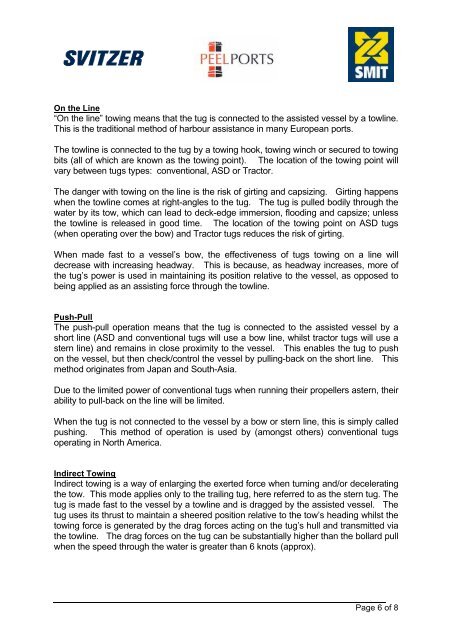Port of Liverpool - Towage Information
Port of Liverpool - Towage Information
Port of Liverpool - Towage Information
You also want an ePaper? Increase the reach of your titles
YUMPU automatically turns print PDFs into web optimized ePapers that Google loves.
On the Line<br />
“On the line” towing means that the tug is connected to the assisted vessel by a towline.<br />
This is the traditional method <strong>of</strong> harbour assistance in many European ports.<br />
The towline is connected to the tug by a towing hook, towing winch or secured to towing<br />
bits (all <strong>of</strong> which are known as the towing point). The location <strong>of</strong> the towing point will<br />
vary between tugs types: conventional, ASD or Tractor.<br />
The danger with towing on the line is the risk <strong>of</strong> girting and capsizing. Girting happens<br />
when the towline comes at right-angles to the tug. The tug is pulled bodily through the<br />
water by its tow, which can lead to deck-edge immersion, flooding and capsize; unless<br />
the towline is released in good time. The location <strong>of</strong> the towing point on ASD tugs<br />
(when operating over the bow) and Tractor tugs reduces the risk <strong>of</strong> girting.<br />
When made fast to a vessel’s bow, the effectiveness <strong>of</strong> tugs towing on a line will<br />
decrease with increasing headway. This is because, as headway increases, more <strong>of</strong><br />
the tug’s power is used in maintaining its position relative to the vessel, as opposed to<br />
being applied as an assisting force through the towline.<br />
Push-Pull<br />
The push-pull operation means that the tug is connected to the assisted vessel by a<br />
short line (ASD and conventional tugs will use a bow line, whilst tractor tugs will use a<br />
stern line) and remains in close proximity to the vessel. This enables the tug to push<br />
on the vessel, but then check/control the vessel by pulling-back on the short line. This<br />
method originates from Japan and South-Asia.<br />
Due to the limited power <strong>of</strong> conventional tugs when running their propellers astern, their<br />
ability to pull-back on the line will be limited.<br />
When the tug is not connected to the vessel by a bow or stern line, this is simply called<br />
pushing. This method <strong>of</strong> operation is used by (amongst others) conventional tugs<br />
operating in North America.<br />
Indirect Towing<br />
Indirect towing is a way <strong>of</strong> enlarging the exerted force when turning and/or decelerating<br />
the tow. This mode applies only to the trailing tug, here referred to as the stern tug. The<br />
tug is made fast to the vessel by a towline and is dragged by the assisted vessel. The<br />
tug uses its thrust to maintain a sheered position relative to the tow’s heading whilst the<br />
towing force is generated by the drag forces acting on the tug’s hull and transmitted via<br />
the towline. The drag forces on the tug can be substantially higher than the bollard pull<br />
when the speed through the water is greater than 6 knots (approx).<br />
Page 6 <strong>of</strong> 8


